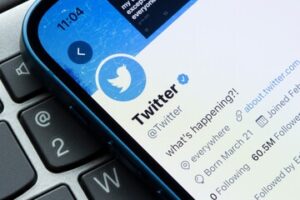
Introduction
Twitter, the iconic microblogging platform, has a rich and fascinating history that traces back to its humble beginnings in the early 2000s. Founded by Jack Dorsey, Noah Glass, Biz Stone, and Evan Williams, Twitter has evolved from a simple idea to a global phenomenon, shaping the way people communicate, share information, and connect with one another.

Birth of an idea
The story of Twitter began in 2006 when Jack Dorsey, an entrepreneur and computer programmer, conceived the idea of a platform that would allow users to share short status updates with their friends. Originally named “twttr,” the platform was inspired by SMS messaging and limited users to 140 characters per message, a constraint that would later become synonymous with Twitter’s identity.
Launch and early growth
On March 21, 2006, Jack Dorsey sent out the first-ever tweet: “just setting up my twttr.” This marked the official launch of the platform, which quickly gained traction among tech enthusiasts and early adopters. As word spread, Twitter attracted a diverse user base, including celebrities, journalists, politicians, and everyday individuals looking to share their thoughts and experiences in real-time.
The rise of hashtags and retweets
In 2007, Twitter introduced two groundbreaking features that would revolutionize the platform: hashtags and retweets. Chris Messina proposed the use of hashtags (#) to categorize tweets and facilitate conversations around specific topics or events. Meanwhile, the concept of retweeting, originally coined by user Eric Rice, allowed users to amplify and share interesting tweets with their followers, further increasing the virality and reach of content on Twitter.
Twitter goes global
By 2009, Twitter had become a global phenomenon, attracting millions of users from around the world. The platform’s real-time nature made it an invaluable tool for breaking news, citizen journalism, and live event coverage. From political uprisings like the Arab Spring to cultural phenomena like the “Ice Bucket Challenge,” Twitter became a primary source of information, commentary, and engagement on a wide range of topics.
Changes to Twitter since Elon Musk’s takeover
Elon Musk’s potential acquisition of Twitter could stem from several strategic motivations and opportunities. Firstly, Twitter provides a vast trove of real-time data and insights, which Musk, known for his data-driven decision-making, could leverage to inform his other ventures, such as Tesla and SpaceX. Secondly, acquiring Twitter would grant Musk access to a powerful platform for shaping public opinion, promoting his companies, and advancing his vision for the future. Additionally, Musk’s interest in Twitter aligns with his strategy of diversifying his business portfolio and expanding his influence across different industries. Owning a major social media platform like Twitter would add another dimension to Musk’s empire and provide new avenues for growth and innovation. Furthermore, Musk may see potential synergies between Twitter and his other ventures, enabling integration and collaboration to enhance user experience and drive value. Overall, the acquisition of Twitter by Elon Musk represents a strategic move that could unlock new opportunities for innovation, influence, and growth in the digital landscape.

Evolution of features and functionality
Over the years, Twitter has introduced a plethora of features and updates to enhance user experience and engagement:
- Multimedia Support: Twitter expanded beyond text-based tweets to include photos, videos, GIFs, and polls, allowing users to express themselves in richer and more diverse ways.
- Moments: Introduced in 2015, Moments curated top tweets and stories around specific events or topics, making it easier for users to discover and engage with trending content.
- Twitter Spaces: Launched in 2020, Twitter Spaces enables users to host and join audio chat rooms, fostering real-time conversations and discussions on various subjects.
- Fleets: Similar to Instagram Stories, Fleets allowed users to share ephemeral content that disappears after 24 hours, encouraging more spontaneous and casual sharing.
Challenges and controversies
Despite its immense popularity, Twitter has faced its fair share of challenges and controversies over the years:
- Harassment and Abuse: Twitter has been criticized for its handling of harassment, hate speech, and abusive behavior on the platform, leading to calls for stricter enforcement and improved moderation tools.
- Misinformation and Fake News: Twitter has grappled with the spread of misinformation, conspiracy theories, and fake news, prompting efforts to combat false information and promote credible sources.
- Platform Manipulation: Twitter has faced scrutiny over the proliferation of bots, trolls, and fake accounts aimed at manipulating public opinion and spreading propaganda, raising concerns about the integrity of the platform.

Looking ahead
As Twitter continues to evolve and adapt to changing user needs and societal dynamics, its future remains both promising and uncertain. With a renewed focus on product innovation, user safety, and platform integrity, Twitter aims to uphold its mission of fostering healthy conversations, amplifying diverse voices, and facilitating meaningful connections in an increasingly interconnected world.
Key features and functionality
At the heart of Twitter lies its distinctive features that set it apart from other social media platforms:
- Tweets: Short messages limited to 280 characters, enabling users to convey thoughts, opinions, news, and updates concisely.
- Followers and Following: Users can follow other accounts to see their tweets in their timeline, while others can follow them in return.
- Retweets and Likes: Users can retweet (share) tweets they find interesting or valuable, amplifying their reach, and expressing appreciation through likes.
- Hashtags: Users can categorize their tweets using hashtags (#), allowing them to join conversations on specific topics and trends.
- Mentions: Users can tag other users in their tweets by using “@” followed by their username, facilitating communication and interaction.
- Media Support: Twitter allows users to include photos, videos, GIFs, and polls in their tweets, enriching content and engagement.
Impact and influence
Twitter has had a profound impact on various aspects of society, including:
- News and Information: Twitter serves as a real-time news source, enabling users to stay updated on current events, trends, and developments around the world.
- Social Activism: Twitter has been instrumental in mobilizing social movements, facilitating activism, and giving voice to marginalized communities.
- Marketing and Branding: Businesses leverage Twitter to connect with customers, build brand awareness, and promote products and services through targeted advertising and engagement.
- Political Discourse: Twitter plays a pivotal role in political discourse, enabling politicians, pundits, and citizens to engage in discussions, debates, and advocacy.
Challenges and controversies
Despite its widespread popularity, Twitter has faced its fair share of challenges and controversies, including:
- Cyberbullying and Harassment: Twitter has been criticized for its handling of harassment and abuse on the platform, prompting calls for stricter policies and enforcement.
- Misinformation and Fake News: Twitter has grappled with the spread of misinformation, conspiracy theories, and fake news, leading to concerns about its impact on public discourse and democracy.
- Platform Manipulation: Twitter has faced scrutiny over the proliferation of bots, trolls, and fake accounts aimed at manipulating public opinion and spreading propaganda.
Benefits of Twitter Exploring the advantages of the Microblogging platform
Twitter offers a myriad of benefits to individuals, businesses, organizations, and communities, making it a valuable tool for communication, networking, and engagement in the digital age. Here are some of the key benefits of using Twitter:
- Real-Time information
Twitter provides users with instant access to breaking news, trending topics, and live events as they unfold. With its real-time nature, Twitter serves as a valuable source of up-to-date information on a wide range of subjects, including news, sports, entertainment, politics, and more.
- Networking and Connectivity
Twitter enables users to connect with like-minded individuals, professionals, influencers, and organizations across the globe. By following and engaging with others in their respective fields, users can build meaningful relationships, expand their networks, and stay connected with peers, mentors, and industry experts.
- Brand awareness and Promotion
For businesses and organizations, Twitter offers a powerful platform for brand building, promotion, and marketing. By sharing compelling content, updates, and announcements, businesses can increase their visibility, reach new audiences, and attract potential customers or clients.
- Customer engagement and Support
Twitter serves as a direct line of communication between businesses and their customers, enabling real-time engagement and support. By responding to inquiries, addressing concerns, and providing assistance promptly, businesses can enhance customer satisfaction, loyalty, and trust.
- Thought leadership and Influence
Twitter provides individuals and organizations with a platform to share their expertise, insights, and opinions on various topics. By consistently providing valuable and engaging content, users can establish themselves as thought leaders in their respective fields, gaining influence and credibility among their followers.
- Market Research and Feedback
Twitter offers valuable insights into customer preferences, opinions, and trends through social listening and engagement. By monitoring conversations, analyzing feedback, and observing market trends, businesses can gather actionable data to inform decision-making, product development, and marketing strategies.
- Crisis communication and Management
During times of crisis or emergencies, Twitter serves as a critical communication tool for disseminating information, providing updates, and addressing concerns. Businesses, governments, and organizations can use Twitter to communicate transparently and effectively, managing crises and mitigating potential damage to their reputation.
- Recruitment and Talent acquisition
Twitter provides a platform for businesses to showcase their company culture, values, and job opportunities, attracting top talent and prospective employees. By leveraging hashtags, targeted advertising, and engaging content, businesses can enhance their employer brand and recruit candidates effectively.
- Community building and Advocacy
Twitter fosters community building and advocacy by bringing together individuals, groups, and organizations with shared interests and causes. From grassroots movements to charitable initiatives, Twitter serves as a rallying point for collective action, raising awareness, and driving positive change.
- Personal Growth and Development
For individuals, Twitter offers opportunities for learning, growth, and self-expression. By following thought leaders, industry experts, and influencers, users can access valuable insights, resources, and perspectives that contribute to their personal and professional development.
Future Prospects and Innovations
Looking ahead, Twitter continues to innovate and evolve, exploring new features and initiatives to enhance user experience and address societal challenges. Some areas of focus include:
- Content Moderation: Twitter is investing in AI-driven tools and human moderation to combat abuse, harassment, and misinformation on the platform.
- Monetization: Twitter is exploring new revenue streams, including subscription services, premium features, and e-commerce integrations, to diversify its income sources.
- Accessibility: Twitter is committed to improving accessibility for users with disabilities, ensuring that its platform is inclusive and user-friendly for all.
- Niche Communities: Twitter aims to foster niche communities and conversations through features like Spaces (audio chat rooms) and Topics (curated timelines), catering to diverse interests and passions.
Change the Twitter name to “X”
Elon Musk’s decision to change his Twitter name to “X” reflects his penchant for innovation, unpredictability, and whimsicality. Musk, known for his unconventional approach to business and communication, often uses social media as a platform to share his thoughts, ideas, and projects with the world. By adopting the enigmatic moniker “X,” Musk may be signaling a desire to break free from conventional norms and expectations, embracing a persona that transcends traditional labels and boundaries.

Furthermore, the letter “X” holds symbolic significance in Musk’s endeavors, representing the unknown, the experimental, and the cutting-edge. As the CEO of SpaceX, Musk has propelled humanity into the realm of space exploration, with projects like the SpaceX Starship aiming to usher in a new era of interplanetary travel. By aligning his Twitter name with the letter “X,” Musk may be alluding to his ongoing mission to push the boundaries of technology, science, and human potential.
Conclusion
In conclusion, Twitter stands as a testament to the power of brevity, connectivity, and conversation in the digital age. From its humble beginnings as a simple SMS-based platform to its current status as a global hub for news, discourse, and engagement, Twitter has left an indelible mark on society. As it continues to evolve and adapt to changing dynamics, Twitter remains a beacon of communication, community, and creativity in an ever-expanding digital landscape.
FAQ’s
Can I DM someone on Twitter who doesn’t follow me?
Yes, you can send a Direct Message (DM) to someone on Twitter even if they don’t follow you. However, the recipient may not receive notifications for DMs from non-followers unless they have adjusted their settings to allow it. Additionally, if a user has enabled the option to receive DMs from anyone, regardless of whether they follow them, you can send them a message.
What is the main purpose of Twitter?
The main purpose of Twitter is to provide a platform for users to share and discover real-time information, news, opinions, and updates in concise and immediate formats. It facilitates communication, engagement, and interaction among individuals, organizations, and communities across the globe.
What should I know before using Twitter?
Before using Twitter, it’s important to understand that the platform operates in real-time, with tweets being publicly visible to anyone unless set to private. Users should familiarize themselves with Twitter’s features, such as hashtags, retweets, and mentions, and understand the importance of brevity due to the character limit imposed on tweets.
What is the basic use of Twitter?
The basic use of Twitter involves sharing short messages, known as tweets, with your followers. Tweets can include text, images, videos, links, and hashtags, and users can engage with content by liking, retweeting, replying, or sharing it with their own followers.
What are the 3 benefits of Twitter?
Real-time Information: Twitter provides access to up-to-the-minute news, updates, and trends from around the world.
Networking and Connectivity: Twitter facilitates connections and interactions with a diverse range of individuals, organizations, and communities.
Amplification of Voice: Twitter enables users to amplify their voices, share their perspectives, and engage in public discourse on various topics of interest.
What is Twitter called now?
Twitter is still commonly referred to as Twitter. There have been no significant name changes for the platform.
What type of platform is Twitter?
Twitter is a social media platform that enables users to communicate, share information, and engage with content in real time. It falls under the category of microblogging platforms due to its short-form content format.
What is Twitter’s target audience?
Twitter’s target audience consists of a diverse range of individuals, including but not limited to journalists, celebrities, politicians, businesses, professionals, activists, and everyday users. The platform appeals to those seeking real-time information, networking opportunities, and public engagement.
How many users does Twitter have?
As of the latest available data, Twitter has over 330 million monthly active users worldwide. This number may vary over time as the platform continues to grow and evolve.
Is Twitter good for society?
The impact of Twitter on society is complex and multifaceted. While it provides a platform for free expression, information sharing, and public discourse, it also faces challenges related to misinformation, harassment, and polarization. Twitter’s influence on society ultimately depends on how it is used by its users and how the platform addresses these issues.

Leave a Comment